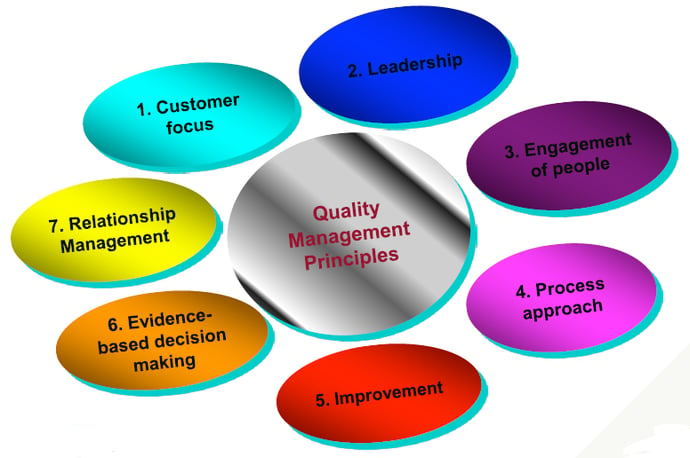How to Get ISO 9001 Certification: From An Expert- Part 3
Mark Braham CQP, FCQI Head of Business Assurance at The AA [Guest Post]If you are looking for some real expert help with how to get ISO 9001 certification, then you couldn't have picked a better article to read; particularly because our guest writer, Mark Braham, is an expert in IS0 9001:2015 (he co-wrote it) and over this three part series, he has explained how you can go about obtaining ISO 9001 certification.
This is the third and last article from Mark, a CQI category A liaison at ISO/TC176, the international working committee responsible for writing lSO 9001:2015. He is the Chair of the UK national standards body (BSI) and managed QS1 who are responsible for collating and drafting all UK responses to ISO (International Organisation for Standardisation) and UK voting on the standard.
In his first article Mark explored:
• the intention behind the latest update of the ISO 9001 standard
• the requirements of a Quality Management System certified to ISO 9001:2015
In his second article Mark examined:
• the thinking behind four of the seven quality management principles Quality Management Principles (QMP)
and
• How to get ISO certified for 2001:2015 against these principles
Now in this third article, Mark takes the same approach to exploring the final three of the seven Quality Management Principles (QMP) and leaves us with some closing thoughts.
Now, over to the expert...
As mentioned in part 2 of this series, certification to ISO 9001:2015 requires passing an audit to check that your quality management system (QMS) delivers on the requirements of the standard underpinned by the seven quality management principles.

Image sourced from:isoconsultantpune.com
These Quality Management Principles (QMPs) are:
QMP 1 – Customer focus: Meeting - and exceeding - your customers' current and future needs is the primary focus of quality management.
QMP 2 – Leadership: Having a unified direction and mission that comes from strong leadership is essential in promoting the right culture.
QMP 3 – Engagement of people: Competent, empowered and engaged people at all levels of your organisation.
QMP 4 – Process approach: Understanding activities as processes that link together and function as a system to yield more effective and efficient results.
QMP 5 – Improvement: Successful organisations have an ongoing improvement focus.
QMP 6 – Evidence-based decision making: Ensuring your decisions are based on the analysis and evaluation of data is more likely to produce the desired result.
QMP 7 – Relationship management: Identifying the important relationships you have with interested parties such as your suppliers – and setting out a plan to manage them – will drive sustained success.
In the second article in this series I explored the first four QMPs. In this article I will take a look at the QMPs covering:
• Improvement (QMP 5)
• Evidenced-based decision making (QMP 6)
• Relationship management (QMP 7)
Exploring for each:
• The thinking behind them
• What is needed to achieve ISO 2001:2015 certification against these principles

QMP 5 – Improvement: Successful organisations have an ongoing improvement focus
Improvement is a major motivator for me. My favourite question my Director asks each year at my annual review is, “How much money did you save us this year?” and I always have a great answer.
Maintaining and growing brand, profit and market share are the lifeblood of any organisation and standing still with any of these results in the organisation means getting left behind. ISO recognise this with QMP 5 - improvement.
Improvement starts with objective setting. It is important that the appropriate objectives are set at all levels of an organisation, with tangible links to the strategic direction of the organisation.
Improvement is best achieved as an approach, a culture for all employees not just auditors or business change teams - so that it continually drives everything that the organisation (and everyone in it) does. It should be the driver behind training, skill setting and the base line expectation for how everyone works.
Practical ways to demonstrate improvement to your ISO 9001:9015 auditor - are to show your continual improvement and change programmes. Improvement can also be quantified by showing root cause analysis, especially that resulting from customer complaints. Use the plan, do, check and act process before change, during the change and after the change to ensure continual improvement and that the process is delivering the correct outputs.
Any programme that identifies the cause of errors, mistakes and defects and make changes to ensure that they are not repeated, demonstrates improvement; as do developments or innovation to enhance and improve the customer experience. Strive to achieve stretch improvement goals and seek to prevent defects or waste.
 Image sourced from: fourthsource.com
Image sourced from: fourthsource.com
QMP 6 – Evidence-based decision making:
Ensuring your decisions are based on the analysis and evaluation of data is more likely to produce the desired result
QMP 6 (evidence based decision making) links closely with QMP 5 (improvement). It is very common for management, especially new management to want to change things. The changes are of course intended to deliver improvement, but of course not all change does.
Some change can be for the worse.
The best way to try and ensure that change does indeed result in improvement, is to base your decisions on objective evidence. Look at the data, analyse it to identify where the improvements lie; where tangible additional benefits can be achieved and then create a pipeline of improvement projects.
Trust the management information but always be open to challenge any statistical data. Don't forget to measure and monitor any changes to verify that those changes have produced customer business or customer benefits.
Identify say six major projects that can be addressed this year (or whatever is the appropriate number for your organisation) and then give focus to doing so.
An ISO 9001:2015 auditor will be looking for the evidence trail back from the decision to make the change. This doesn’t have to be very complex, just a record of the actual data which indicated that a change should be made. Did the business case deliver the correct outcomes? Was the financial benefit realised?
 Image sourced from: media.licdn.com
Image sourced from: media.licdn.com
QMP 7 – Relationship management:
Identifying the important relationships you have with interested parties such as your suppliers – and setting out a plan to manage them – will drive sustained success
Historically QMP 7 was supplier focused and about getting the best possible price from your suppliers. However, with the latest version, the focus is much more about working in partnership with your supply chain to ensure the best possible outcome for the end customer. This approach delivers far more benefit for everyone.
Successful relationships along the supply chain are absolutely key for the organisation that I work for with critical suppliers supporting our strategic objectives. For example, we work closely with a whole host of garages, whose employees are trained by The AA, and who are also audited and certified by The AA to ensure that our customers receive the service that they expect and require.
The ISO 9001:2015 auditor will be looking for information on the relationships that are key for your organisation and how you plan to manage that relationship to the benefit of all. This control is adaptable depending on the scale, risk and cost to your organisation.
Some final thoughts
I hope that this review of the thinking behind each of the seven Quality Management Principles in respect of ISO 9001:2015 has been interesting and the examples of what an ISO 2001:2015 auditor is looking to award certification against have been useful.
Just before I close off on the series I would like to reflect on the following:
• The benefits of the changes to ISO 9001
• Choosing your ISO 9001 certification body
The benefits of the changes to ISO 9001
I was very pleased to be involved in the redrafting of the ISO 9001 standard and feel that a number of positive outcomes have been achieved in the latest version.
• The standard is now far more scalable. It applies equally to a micro-business as a global organisation. I think this is the biggest win.
• The focus on leadership is also a great improvement. If your senior management team doesn’t support your quality management system, it is almost impossible to implement an effective system.
• There is far less opportunity to become ISO certified just for the badge on the wall. Your Quality Management System must be being properly utilised as a Business Management System in order to pass the audit. This is not good news for those organisations who have previously just ticked boxes to pass the audit, but for those organisations managing their businesses effectively and continually improving, ISO 9001:2015 certification is real recognition of the value being delivered.
Choosing your ISO 9001 auditor
It is important to remember that certifying bodies are a supplier. So apply the principles of ISO 9001 to choosing yours. If they don’t deliver what you need – move on.
Your Quality Management System needs to work for your organisation. This means that it should be structured in a way that works for your organisation and use the language that works for your organisation too. Your auditor does not have the right to ask you to change this. Nor do they have the right to ask you for a single document to show clause-by-clause compliance with “clause XYZ”.
It’s all about the seven QMPs.
As mentioned in the introduction, the deadline for transitioning to ISO 9001:2015 is September 2018. Some certification bodies are insisting on gap reviews, prior to audit. This isn’t a requirement, but it may be useful if you feel unconfident about going straight for the audit.
There is plenty of advice available about achieving ISO 9001:9015 - from the International Accreditation Forum, UKAS and the many consultants out there. Your certification body cannot deliver consultancy and in many cases you just won’t need it – if you have an effective quality management system in place – you won’t be far off achieving ISO 9001:2015 certification.
Thank you Mark. We very much appreciate you sharing your knowledge, insights and expertise with us in this excellent three part series.
To download Mark's white paper containing all the help and expertise covered in the three part series, click the GET IT NOW button below:
Related Articles:
How to Get ISO Certified From An Expert on ISO 9001:2015
How to Get ISO Certified From an Expert on ISO 9001:2015- Part 2Achieving ISO 9001:2015 with Business Process Management (BPM)
How to stop ISO Certification running your business
Business Process Management vs Quality Management vs Enterprise Architecture vs Workflow Management

